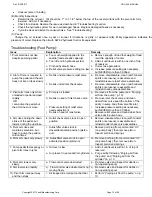
Rev. 9/25/2017
HDC-450, MANUAL
Copyright 2017 Vestil Manufacturing Corp. Page 24 of 26
Troubleshooting Guide (HDC-DC & HDC-AC):
Contact technical support to resolve issues not addressed in this guide.
Issue
Possible Cause
Remedy
1. Pivot arm does not rise and
motor does not run
a. [HDC-DC] Low battery voltage
.
(Check
light)
b. [HDC-AC] All chassis connections to
negative post of battery not made well.
a. Recharge battery
b
.
Check and tighten or clean connections if
necessary.
2. Pivot arm does not rise but
motor is running or humming.
c.
Voltage at motor terminals might be too low
to run pump at existing load.
d. Fluid level in reservoir is low.
e. Load exceeds capacity requirements
.
Relief valve is allowing hydraulic fluid to flow
back into the reservoir
.
f. Suction filter is clogged, starving pump.
g
.
Suction line fittings are loose allowing air to
enter.
h. Filter/Breather cap on tank is clogged.
i. Lowering solenoid valve might be energized
by faulty wiring or might be stuck open
.
j
.
Hydraulic pump not operating.
c. Measure voltage at motor terminals (as near as
possible) while pump runs under load. Check for
loose wiring connections.
d
.
Add fluid. (See “Monthly inspections” and
“Yearly inspection” on p. 23 for proper fluid level
.)
e. DO NOT CHANGE RELIEF VALVE SETTING.
Instead, reduce the load to rated capacity.
f. Remove filter and clean.
g. Inspect all fittings for proper tightness.
h. Remove cap and clean
.
i.
Remove lowering solenoid valve. Check and
clean.
(Refer
to “Lowering Solenoid Valve” on p.
20.)
j. Disconnect hydraulic line from power unit. Put
pressure line in a large container and operate
the
pump. If no output
,
check the pump motor coupling
and correct as appropriate
.
If pump is worn
,
contact factory for replacement parts.
3. Pivot arm rises too slowly
.
k
.
Foreign material stuck in lowering solenoid
valve causing fluid to flow back into the
reservoir.
l. Foreign material clogging suction filter or
breather cap, or a hose is pinched.
m. Low motor voltage
.
n. Unit overloaded.
o. Inoperative pump.
k. Lower the carriage
.
Remove the lowering
solenoid valve and clean
.
(Refer to p. 20).
l
.
Correct as appropriate. (See also
,
2(f), (h)).
m
.
See 1 (b)
n
.
See 2 (e)
o. See 2 (j)
4. Motor labors or is extremely
hot.
p. [HDC-DC] Battery voltage too low.
q. Oil starvation causing pump to bind &
overheat. [NOTE: If this occurs, pump can be
permanently damaged.]
r. Binding cylinder.
p. See 1 (b)
q
.
See 2 (d), (f)
,
(g)
,
(h), (j)
r
.
Align cylinder correctly.
5
.
P
ivot arm rises in jerks or is
spongy when elevated.
s
.
Fluid starvation
.
t. Air in system
.
s
.
See 2
(d),
(f)
,
(g), (j)
t
.
See “Bleeding air from the hydraulic circuit” (p.
20).
6. Pivot arm lowers too slowly
when loaded
.
u. Lowering solenoid valve filter screen
clogged.
v. Pinched tube or hose
.
w
.
Foreign material in flow control valve.
x. Binding cylinders
.
y. Foreign material in velocity fuse.
u
.
Remove lowering solenoid valve and clean filter
screen.
v. Correct as appropriate.
w
.
Remove and clean flow control valve. Refer to
Hydraulic Circuit Diagram on p. 19)
.
x
.
Align cylinders correctly.
y. Remove and clean velocity fuse. Refer to
Hydraulic Circuit Diagram on p. 19)
.
7
.
Pivot arm lowers too quickly
.
z. Foreign material stuck in flow control valve.
(In
this case, carriage initially lowers at a
normal rate but accelerates as the carriage
descends).
z. Remove flow control valve from the valve block
and clean. (Refer to Hydraulic Circuit Diagram on
p. 19)
.
8. Pivot arm rises then slowly
lowers on its own.
aa
.
Lowering solenoid valve may be
incorrectly wired or is stuck open
bb. Check valve stuck open.
cc. Leaking hoses, fittings, pipes
.
dd
.
Cylinder packing is worn or damaged
.
aa
.
See 3 (k)
.
bb. Remove and clean check valve
.
cc. See 2 (c).
dd
.
Replace packing
(contact
factory for
replacement parts).
9. Pivot arm elevates but does
not lower
.
ee. Incorrect lowering solenoid valve wiring
.
ff
.
Lowering solenoid valve
i
s stuck.
gg. Faulty lowering solenoid coil.
ee
.
Correct per diagram (p. 15 (DC) or 18 (AC))
.
ff
.
Lightly tap down the solenoid coil body to seat it
properly
.
(DO NOT hit coil hard as it will
permanently damage the internal system
.
DO NOT
remove the solenoid valve from the block because
the
carriage will descend dangerously quickly.)
gg
.
Remove and replace. DO NOT remove the



































